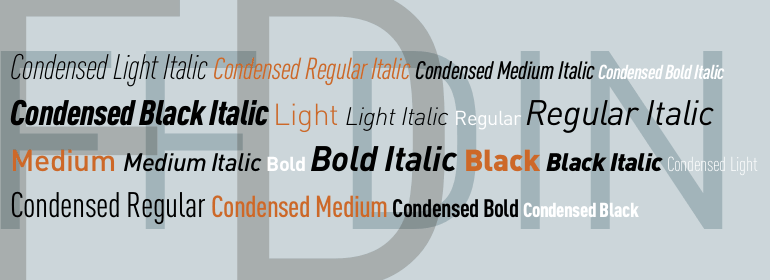- MD5值:
FF DIN®
英文名字:zhuan_DINPro-Thin.TTF
字體介紹
FF DIN®
品牌:FontFont(Monotype)
設計師:Pool,Albert-Jan
發行時間:2018
字庫編碼:Unicode
分類:無襯線體
字體屬性:
1994, San Francisco: Albert-Jan Pool and Erik Spiekermann took a cab together from the ATypI conference to the airport. Having known that Pool s employer had just gone bust, Spiekermann told him that if he wanted to earn some money with type design, he should have looked at fonts such as OCR and DIN. He invited Pool to Berlin to discuss the idea in detail. One year later, FontFont published Pool s FF OCR-F typeface, followed by FF DIN. Spiekermann was keenly aware of an empty space in the market. Digital DIN fonts were available at the time, but only in two weights of purely geometric shapes. Pool then designed a family of five weights. He added true italics and some alternative characters, such as the i with a round dot and lowercase figures. Later, five weights of FF DIN Condensed were added, as well as Greek and Cyrillic versions. The shape of the new FF DIN differs from the original mostly by thinner horizontal strokes and more fluent curves. Despite its primitive, technical look and clear reference to the German motorway signboards, FF DIN has become a phenomenon. The typeface has pervaded corporate and publication typography, and found its place in posters of cultural institutions. In 2011, the Museum of Modern Art in New York added the first digital typefaces to its permanent collection. Presumably due in part to the immense popularity enjoyed by FF DIN since its release in the mid-1990s, it was one of 23 designs to be included. FF DIN debuted at MoMA as part of the Standard Deviations installation in the contemporary design gallery. In 2014, German type designer Yanone was commissioned by FontFont to extend the popular FF DIN into the Arabic alphabet. Yanone had previously designed the corporate typeface for Jordan s capital Amman which was published as FF Amman in Latin and Arabic, and had secretly hoped that he could one day design FF DIN s Arabic counterpart. Coincidentally, he chose a similar approach to the development of the original DIN in the early 1900s, which started out as a hand-written master drawing and later resulted as standard DIN 1451. Yanone engineered FF DIN Arabic, published in 2015, by basing the letter shapes and proportions on a simplified hand-written Naskh skeleton on a grid. Step by step he boiled down the shapes into the digital master drawings that feature the same clarity and legibility of the Latin DIN. In 2015, two new weights Thin and Extra Light (with Italics) for both FF DIN (Normal) and FF DIN Condensed were added to the family. New Greek extensions were also introduced.
字體圖片

